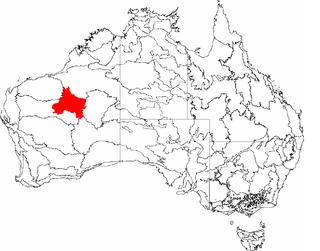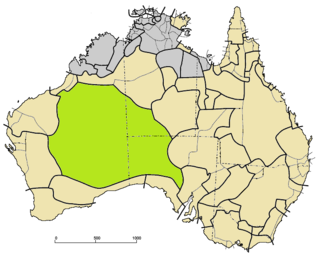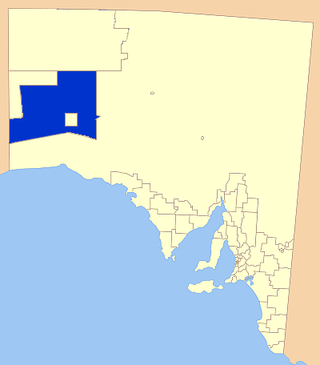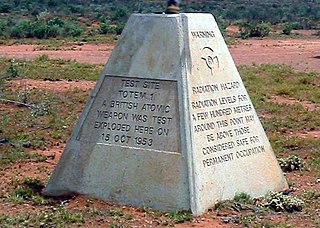
Wiluna is a small town in the Goldfields-Esperance region of Western Australia. It is situated on the edge of the Western Desert at the gateway to the Canning Stock Route and Gunbarrel Highway. It is the service centre of the local area for the local Martu people, the pastoral industry, the Wiluna Gold Mine, and many more people who work on other mines in the area on a "fly-in/fly-out" basis. Wiluna's climate is hot and dry, with an annual rainfall of 258 millimetres (10.2 in). Mean maximum temperatures range from 19 °C (66 °F) in July, to 38 °C (100 °F) in January.

Kumpupintil Lake, formerly known as Lake Disappointment, is an endorheic salt lake located in the Little Sandy Desert, east of the Pilbara region of Western Australia.

Woomera, unofficially Woomera village, refers to the domestic area of RAAF Base Woomera. Woomera village has always been a Defence-owned and operated facility. The village is located on the traditional lands of the Kokatha people in the Far North region of South Australia, but is on Commonwealth-owned land and within the area designated as the 'Woomera Prohibited Area' (WPA). The village is approximately 446 kilometres (277 mi) north of Adelaide. In common usage, "Woomera" refers to the wider RAAF Woomera Range Complex (WRC), a large Australian Defence Force aerospace and systems testing range covering an area of approximately 122,000 square kilometres (47,000 sq mi) and is operated by the Royal Australian Air Force.

The Little Sandy Desert (LSD) is a desert region in the state of Western Australia, lying to the east of the Pilbara and north of the Gascoyne regions. It is part of the Western Desert cultural region, and was declared an interim Australian bioregion in the 1990s.

The Western Desert language, or Wati, is a dialect cluster of Australian Aboriginal languages in the Pama–Nyungan family.

The Maralinga Tjarutja, or Maralinga Tjarutja Council, is the corporation representing the traditional Anangu owners of the remote western areas of South Australia known as the Maralinga Tjarutja lands. The council was established by the Maralinga Tjarutja Land Rights Act 1984. The area is one of the four regions of South Australia classified as an Aboriginal Council (AC) and not incorporated within a local government area.

The 2005 Cronulla riots were a series of race riots in Sydney, New South Wales, Australia. It began in the beachside suburb of Cronulla on 11 December, and spread over to additional suburbs the next few nights.
The Martu (Mardu) are a grouping of several Aboriginal Australian peoples in the Western Desert cultural bloc.

A woomera is an Australian Aboriginal wooden spear-throwing device. Similar to an atlatl, it serves as an extension of the human arm, enabling a spear to travel at a greater speed and force than possible with only the arm.

The Western Desert cultural bloc is a cultural region in central Australia covering about 600,000 square kilometres (230,000 sq mi), used to describe a group of linguistically and culturally similar Aboriginal Australian nations.

Operation Totem was a pair of British atmospheric nuclear tests which took place at Emu Field in South Australia in October 1953. They followed the Operation Hurricane test of the first British atomic bomb, which had taken place at the Montebello Islands a year previously. The main purpose of the trial was to determine the acceptable limit on the amount of plutonium-240 which could be present in a bomb.

HMAS Woomera was an Australian naval vessel operated by the Australian Army and Royal Australian Navy (RAN). Built in Fremantle, Western Australia, she was one of a class of 32 wooden motor vessels intended for the Department of Commerce, but later allocated to the Army. She initially entered service in late 1945 as AV 1356 (Ashburton), before being transferred to the RAN on 23 January 1946 and commissioned as Woomera. The ship's main role was carrying stores and dumping obsolete ammunition surplus from all three military services at sea. In this role she visited many ports in Australia and New Guinea.
Donald George Mackay CBE was an Australian outdoorsman, long-distance cyclist, and explorer who conducted several expeditions to the remotest areas of the Australian continent.

Parnngurr is a medium-sized Aboriginal community, located 370 km from Newman in the Pilbara region of Western Australia, within the Shire of East Pilbara. Parnngurr was originally known as Cotton Creek, the name of the ephemeral creek that runs beside the community.

Punmu is an Aboriginal community, located 640 km south east of Port Hedland in the Pilbara region of Western Australia, within the Shire of East Pilbara.

The RAAF Woomera Range Complex (WRC) is a major Australian military and civil aerospace facility and operation located in South Australia, approximately 450 km (280 mi) north-west of Adelaide. The WRC is operated by the Royal Australian Air Force (RAAF), a division of the Australian Defence Force (ADF). The complex has a land area of 122,188 km2 (47,177 sq mi) or roughly the size of North Korea or Pennsylvania. The airspace above the area is restricted and controlled by the RAAF for safety and security. The WRC is a highly specialised ADF test and evaluation capability operated by the RAAF for the purposes of testing defence materiel.
Walter Batchelor MacDougall was an Australian missionary and patrol officer who worked with the indigenous peoples in the desert regions of Western Australia and South Australia
The Mandjildjara, also written Manyjilyjarra, are an Aboriginal Australian people of Western Australia.
The Nakako are an Aboriginal Australian people of Western and Southern Australia.
Warri (1909–1979) and Yatungka (1919–1979) were an Aboriginal couple from the Mandildjara tribe of the Gibson Desert in Western Australia who spent about 40 years isolated and living nomadically in the Australian desert.













